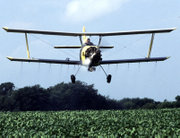Pest Control
Pest control refers to the regulation or management of a species defined as a pest, usually because it is perceived to be detrimental to a person's health, the ecology or the economy. more...
Pest control is at least as old as agriculture. In order to maximize food production, it is advantageous to protect crops from competing species of plants, as well as from herbivores competing with humans.
The conventional approach was probably the first to be employed, since it is comparatively easy to destroy weeds by burning them or plowing them under, and to kill larger competing herbivores, such as crows and other birds eating seeds. Techniques such as crop rotation, companion planting (also known as intercropping or mixed cropping), and the selective breeding of pest-resistant cultivars have a long history.
Many pests have only become a problem because of the direct actions of humans. Modifying these actions can often substantially reduce the pest problem. In the USA, raccoons caused a nuisance by tearing open refuse sacks. Many householders introduced bins with locking lids, which deterred the raccoons from visiting. House flies tend to accumulate wherever there is human activity and is virtually a global phenomenon, especially where food or food waste is exposed. Similarly, seagulls have become pests at many seaside resorts. Tourists would often feed the birds with scraps of fish and chips, and before long, the birds would become dependent on this food source and act aggressively towards humans.
In the UK, following concern about animal welfare, humane pest control and deterrence is gaining ground through the use of animal psychology rather than destruction. For instance, with the urban Red Fox which territorial behaviour is used against the animal, usually in conjunction with non-injurious chemical repellents.
Chemical pesticides date back 4,500 years, when the Sumerians used sulfur compounds as insecticides. The Rig Veda, which is about 4,000 years old, also mentions the use of poisonous plants for pest control. Ancient Chinese and Egyptian cultures are known to have used chemical pest controls. But it was only with the industrialization and mechanization of agriculture in the 18th and 19th century, and the introduction of the insecticides pyrethrum and derris that chemical pest control became widespread. In the 20th century, the discovery of several synthetic insecticides, such as DDT, and herbicides boosted this development. Chemical pest control is still the predominant type of pest control today, although its long-term effects led to a renewed interest in traditional and biological pest control towards the end of the 20th century.
Read more at Wikipedia.org




